
Medial Branch Block
A medial branch block is an injection is a diagnostic injection of local anesthetic (e.g., bupivacaine) on the medial branch nerves that supply sensation to the facet joints. The facet joints, also known as the zygapophysial joints, are part of the bony framework of the spine. They are small bony projections from one vertebra meeting with similar bony projections from the vertebra above or below. A variety of acute and chronic conditions can inflame facet joints.
For lower back (lumbar) facet joints, the pattern of pain is usually an achiness in the low back, radiating across the lower back and slightly down the back of the buttocks and upper thighs. Standing or bending backward worsens the pain.
For neck (cervical) facet joints, the pattern of pain is an achiness in the neck, slight radiation across the neck and shoulders, and worsening symptoms with turning the head from side to side or looking up.
How long does this procedure take?
The injection takes only a few minutes. Please allow about an hour for the procedure; this will include talking to your doctor before the procedure, signing the informed consent, positioning in the room, and observation by the recovery room nurse afterwards.
What medicines are injected?
The injection consists of a mixture of local anesthetic (e.g., bupivacaine).
Will it hurt?
Our procedures begin by injecting a small amount of local anesthetic through a very small needle. It feels like a little pinch and then a slight burning as the local anesthetic starts numbing the skin. After the skin is numb, the procedure needle feels like a bit of pressure at the injection site. If you experience any pain during the procedure, your doctor will inject more local anesthetic as needed.
Will I be "put out" for this procedure?
No. This procedure is done under local anesthesia.
How is the procedure performed?
The procedure is performed with you lying on your stomach for back injections and on your side for neck injections. Your blood pressure and oxygenation will be monitored. In addition to your doctor and the x-ray technician, there will be a nurse in the room at all times if you have any questions or discomfort during the procedure.
The skin on the back is cleaned with antiseptic solution and then the procedure is done. Small needles are placed along the bony landmarks that mark the location of the medial branch nerves. A small volume, about on milliliter, is injected along each nerve.
What should I expect after the injection?
After the injection, your pain may be gone or considerably less. This is due to the effect of the local anesthetic and lasts only for a few hours to a few days.
What should I do after the procedure?
Perform the activities as tolerated by you. This is a diagnostic test and it is important to maintain reasonably normal activities so the block's efficacy can be evaluated.
Can I go back to work the same day?
You should be able to return to work. Your doctor or recovery room nurse will discuss this with you.
How long does the block last?
The injection seldom lasts more than a few hour or a couple of days. This injection is performed as a predictor of the efficacy of Radiofrequency Lesioning of these medial branch nerves.
How many injections do I need?
Usually one in any region (lumber, cervical, thoracic); multiple levels are blocked simultaneously, usually on one side only.
If relief is experienced on the injected side but not on the opposite side, the diagnostic block is a success. The next step is Radiofrequency Lesioning of the medial branch nerve.
Some payers (Medicare and certain insurance companies) require two series of diagnostic injections before Radiofrequency Lesioning.
How will I know if these procedures will help my pain?
It is difficult to predict how helpful injections will be. Patients who have the symptoms described above will do well. Since there are several pain generators in the spine, the degree of response varies.
If you do not obtain reasonable relief from this diagnostic injection, it is unlikely you will obtain relief from Radiofrequency Lesioning. Your doctor will discuss the results with you.
See our article on Radiofrequency Lesioniong
